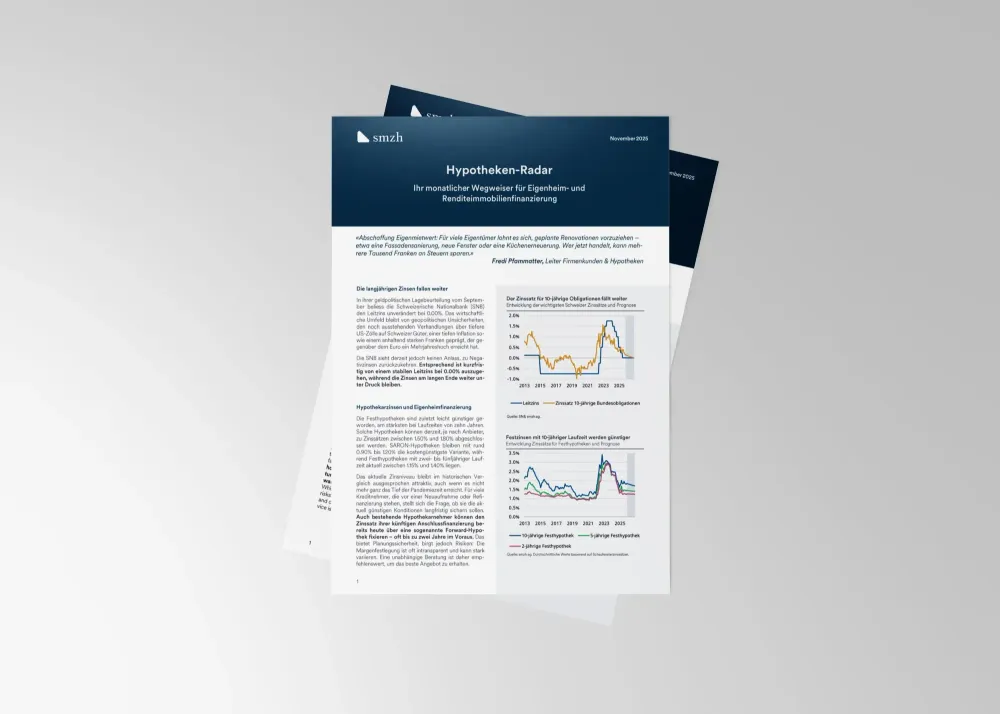A mortgage increase gives you the opportunity to obtain additional funds, whether for renovations, conversions, the purchase of further residential property, or other financial needs. The existing loan amount is increased based on the current market value of your property and your financial capability.

Mortgage increases are generally tied to a specific purpose, such as renovations or refurbishments. Using the funds for other purposes, for example for private consumption, is typically not permitted. The bank or provider will usually require documentation on the intended use of the funds.
If you have already used retirement savings from the 2nd or 3rd pillar to purchase a property (e.g., in the context of the Swiss home ownership promotion or "WEF" program), you may be restricted when seeking to increase your mortgage. Repaying such funds may need to take precedence over a mortgage increase.
Banks and other mortgage providers often apply the "lower value principle." This means that, when increasing a mortgage, the lower value between the original purchase price and the current market value of a property is used as a basis for calculation. This can influence the maximum loan-to-value ratio, particularly in an environment of falling real estate prices.
Determine how much additional capital you need and what it should be used for.
Think about whether the mortgage increase is in line with your provider's requirements or whether an alternative financing option might be more sensible.
Request a professional valuation of your property and check whether the lower value principle applies.
Determine whether the value of your property is sufficient to support the planned increase.
If you have already withdrawn retirement savings, check whether this restricts your financing options and, if yes, what restrictions apply.
Check whether you need to repay the retirement savings before a mortgage increase is approved.
Calculate whether the additional financial burden is viable in the long run, also taking account of potential interest rate increases in the future.
Document how the funds will be used in order to fulfil the requirements of your mortgage provider.
Negotiate the new terms and request a careful review of the contract. Pay close attention to notice periods, interest rates, and potential additional conditions.

Stay one step ahead at all times: Our Mortgage Radar provides details about developments and trends on the Swiss mortgage market – right from the desk of our experts.

Our latest Outlook Real Estate Market provides an overview of recent developments, opportunities, and trends – an in-depth analysis from our experts.
Monthly updates on real estate and mortgages. Subscribe now and identify opportunities early.

Our experts support you throughout the entire process of increasing your mortgage:
Together let us plan your mortgage increase and implement it in the best possible way:

We handle questions such as those shown on the right on a daily basis. You don't need to deal with them by yourself – our 360° Check-Up is free of charge and non-binding.
The lower value principle means that, to calculate the maximum mortgage increase, the lower value of original purchase price and current market value of a property is used.
No, mortgage increases are granted for a specific use case. The funds must be used for residential property purposes such as renovations or modifications.
If you have previously withdrawn pension assets under the promotion of home ownership program, your maximum loan-to-value ratio may be restricted. In addition, you may be required to repay the pension assets.
The annual financial cost (mortgage rates, amortizations, and maintenance) must generally not exceed 33% of your annual gross income.
A loss in value may restrict your financing options, as the loan-to-value limit may be insufficient. If that is the case, we will examine alternative solutions for your needs.